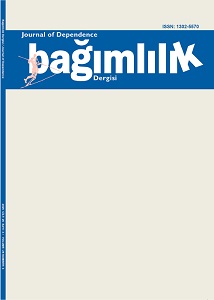EVALUATİON OF DROPOUT REASON FROM ADDİCTİON TREATMENT
Keywords:
Substance related disorders, alcoholism, heroin dependence, patient dropoutsAbstract
Objective:Remission rates among patients with alcohol and substance addictions are low. Dropout of treatment, which can be referred to as relapse, is an unresolved issue in addiction therapy. In this study, we evaluated the treatment dropout reasons of inpatients with substance addictions in the Trakya University, Balkan Addiction Research and Treatment Unit.
Method: 130 patients receiving inpatient addiction treatment during the course of one year were included in this study. The patients’ socio-demographic characteristics and substance use characteristics related to their addictions were retrospectively evaluated with the assistance of a questionnaire and the Addiction Profile Index Scale (API). Upon admission, patients received both written and verbal information regarding the recommended 28-day treatment program. Those who agreed to follow the treatment formed the study sample. The data from the 70 patients who dropped out of the treatment program were compared with those from the 60 who finished their treatment. This study set out to evaluate the psychological and social factors that lead treatment program participants to discontinue treatment.
Results: Of the 130 alcohol and substance addicted patients that participated in the study, 60 patients (46.2%) completed the 28-day treatment program. The mean age of those who completed their treatment was 38.2±14.1 years, while it was 31.8±9.5 years for the drop-out patients, a statistically significant difference. There was no remission in 78.5% of the patients and for 61.5% of the patients; this was their first inpatient treatment. The dropout rates in opiate and alcohol addicted patients were 20.7% (n=6) and 45.7% (n=21), respectively. The dropout rates for cannabis and poly substance users were higher than the others and statistically significant. The mean age for beginning tobacco use among dropout patients was 14.6±4.5, while it was 16.1±3.3 among those who completed treatment, which is statistically significant. The dropout rate was significantly higher among patients with low anger management level as determined by API.
Conclusion: The dropout rate among cannabis users, synthetic cannabis users, and poly substance users was higher. Other related issues were early tobacco use and lower anger management level. Attention to these factors during addiction treatment could reduce instance of relapse.
References
Türkiye Uyuşturucu Raporu. T.C. İçişleri Bakanlığı Emniyet Genel Müdürlüğü. EM-CDDA 2014 Ulusal Raporu (2013 verileri). TUBİM 2014. http://www.kom.pol.tr/tubim/SiteAssets/Sayfalar/T%C3%BCrkiye-Uyu%C5%9Fturucu-Raporu/TUBIM%20 2014%20 TURKIYE%20UYUSTURUCU%20 RAPORU_TR.pdf (24 Mart 2015’te ulaşıldı).
American Psychiatric Association: Diagnostic and Statistical Manual of Mental Disorders, Fifth Edition. Arlington, VA, American Psychiatric Association, 2013.
Brorson HH, Ajo Arnevik E, Rand-Hendrik-sen K, et al. Drop-out from addiction treatment: a systematic review of risk factors. Clin Psychology Rev 2013; 33: 1010-1024.
McHugh RK, Murray HW, Hearon BA, et al. Predictors of dropout from psychosocial treatment in opioid-dependent outpatients. Am J Addict 2013; 22: 18-22.
Alho H, Littlewood R, Maremmani I. Defining a new approach to measuring outcomes in opioid dependence management. Heroin Addict Relat Clin Probl 2014; 16:11-16.
Li X, Sun H, Purl A, et al. Factors associated with pretreatment and treatment dropouts among clients admitted to medical withdrawal management. J Addict Dis 2007; 26:77-85.
Ögel K, Evren C, Karadağ F, ve ark.. Bağımlılık Profi l İndeksi’nin (BAPİ) geliştirilmesi, geçerlik ve güvenilirliği. Türk Psikiyatri Derg 2012; 23:264-273.
Darke S, Campbell G, Popple G. Retention, early dropout and treatment completion among therapeutic community admissions. Drug Alcohol Rev 2012; 31: 64-71.
Lopez-Goni JJ, Fernandez-Montalvo J, Arteaga A. Addiction treatment drop-out: exploring patients’ character- istics. Am J Addict 2012; 21: 78-85.
López-Goñi JJ, Fernández- Montalvo J, Illescas C, et al. Determining socio-demographic predictors oftreatmentdropout: resultsin a therapeutic community. Int J Soc Welf 2008; 17:374-378.
Stevens A, Radcliffe P, Sanders M, et al. Early exit: estimating and explaining early exit from drug treatment. Harm Reduct J 2008; 5:13.
Stulz N, Thase ME, Gallop R, et al. Psychosocial treatments for cocaine dependence: the role of depressive symptoms. Drug Alcohol Depend. 2011; 114: 41-48.
Lejuez CW, Zvolensky MJ, Daughters SB, et al. Anxiety sensitivity: a unique predictor of dropout among inner-city heroin and crack/ cocaine users in residential substance use treatment. Behav Res Ther 2008; 46:811-818.
Pacini M, Giovanni AIM, Ceccanti M, et al. Former heroin-dependent alcohol use disorder patients. Prevalence, addiction history and clinical features. Alcohol and Alcoholism, 2015; 1–7. 2015.
Raylu N, Kaur I. Relationships between treatment expectations and treatment outcomes among outpatients with substance use prob-lems.IntJ MentHealthAddict2011; 10:607-621.
Ohlin L, Hesse M, Fridell M, et al. Polysubstance use and antisocial personality traits at admission predict cumulative retention in a buprenorphine programme with mandatory work and high compliance profile. BMC Psychiatr 2011; 11: 81.
Gilchrist G, Langohr K, Fonseka F. Factors associated with discharge against medical advice from an alcohol and drug inpatient detoxification unit in Barcelona between 1993 and 2006. Heroin Addict Relat Clin Probl 2012; 14:35-44.
McLaughlin KA, Green JG, Hwang I, et al. Intermittent explosive disorder in the National Comorbidity Survey Replication Adolescent Supplement. ArcGen Psychiatr2012; 69: 1131-1139.
Sittambalam CD, Vij R, Ferguson RP. Buprenorphine outpatient outcomes Project: can Suboxone be a viable outpatient option for heroin addiction? J Com Hosp Inter Med Perspect 2014; 4: 1-6.
Smyth BP, Fagan J, Kernan K. Outcome of heroin-dependent adolescents presenting for opiate substitution treatment. J Subst Abuse Treat 2012; 42: 35-44.
Subramaniam GA, Warden D, Minhajud-din A, et al. Predictors of abstinence: national institute of drug abuse multisite bu-prenorphine/naloxone treatment trial in opioid-dependent youth. J Am Acad Child Adoles Psychiatr 2011; 50:1120-1128.
Doğanavşargil GÖ, Sertöz ÖÖ, Coşkunol H, ve ark. EÜTF psikiyatri anabilim dalı bağımlılık tedavi Biriminin hasta verilerinin on yıllık geriye dönük olarak incelemesi: madde kullanan hastaların sosyodemografik özellikleri. Bağımlılık Dergisi 2004; 5: 115-120.
Downloads
Published
How to Cite
Issue
Section
License
Copyright (c) 2025 Journal of Dependence

This work is licensed under a Creative Commons Attribution-NonCommercial-NoDerivatives 4.0 International License.
...
